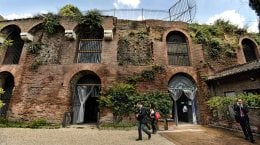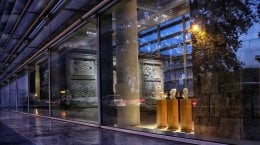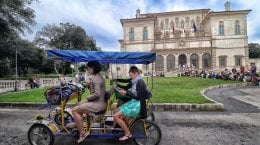Official Reseller Rome and Vatican – Jubilee 2025
Ara Pacis
The monument of the Goddess of Peace
The Ara Pacis Augustae was built in the year B.C. 9; the altar of peace dedicated to Augusto Giulio Cesare, the first emperor of Rome, represents one of the most important testimonies of Augustan art.
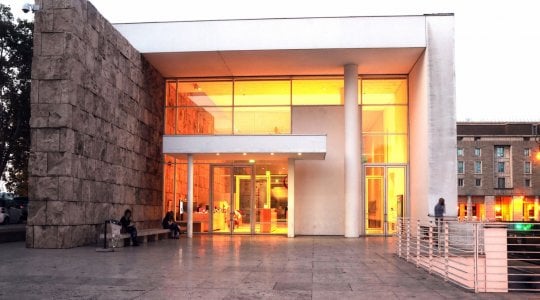
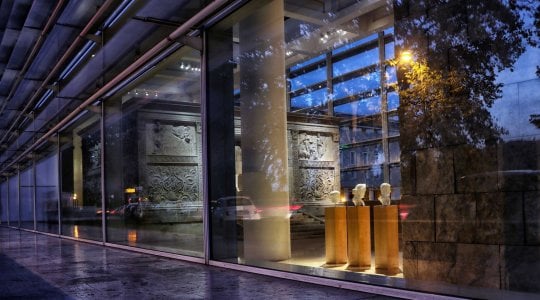
The Ara Pacis Augustae was built in the year B.C. 9; the altar of peace dedicated to Augusto Giulio Cesare, the first emperor of Rome, represents one of the most important testimonies of Augustan art.
The Senate of Rome decided to build the Ara Pacis to pay homage to Augusto, in B.C. 13, after his return from Spain and Gaul where he had remained for three years to pacify those territories. The Senate decided indeed that a monument had to be built to celebrate the success and newfound peace.
The place that was chosen to raise this monument is a point in Rome that, on one side, has a view of Campo Marzio and on the other, of the entrance to the Flaminia consular road.
Given the proximity of the river Tiber that, at that time, was not protected by any walls, the monument was immediately subject to various damages caused by the water of the river and by the humidity, which caused several cracks to the main body.
It was even necessary to raise a suitable brick wall in order to protect the Ara from the invasion of mud and silt from the river.
At the fall of the Roman Empire, like other monuments, the Ara Pacis was soon forgotten and during the late Middle Ages, it was plundered of the marble with which it had been built.
Its remains had merged with the dirt (soil) and were discovered in the mid-sixteenth century, when some fragments of the beautiful reliefs that were part of the altar were found and that, in part, were sold and partly entered into art collections of some nobles of the time. Excavations conducted in the mid-nineteenth century, saw the recovery of the head of Mars and the relief of Enea, but only at the beginning of the 20th century regular research to recover findings belonging to the Ara Pacis were undertaken.
Thanks to the new town plan of 1909, all the buildings around the Mausoleum of Augustus were demolished and it was decided, immediately afterwards, to gather all the findings of the Ara Pacis that had been found up to that time. Nevertheless, it was only in 1937 that the slow and Carthusian assembly of the findings and the reconstruction of the Ara Pacis began. The Ara Pacis was later inaugurated in September 1938.
All the original fragments that had been recovered in Italy and abroad- where they were in possession of wealthy collectors- were applied to the totally rebuilt monument from scratch.
During the war, the reliquary put up to protect the monument was destroyed and in 1950 the Fine Arts announced a national contest to plan the redevelopment of the entire complex of the Ara Pacis, which was later put into practice after the decision made by a special commission in the middle of 1944.
The Ara Pacis
The reconstruction of the Ara Pacis was carried out by trying to rely on studies on the styles of other Roman constructions from the same period and on the depictions found on some Roman coins.
The monument is represented by an enclosure that has an elegant interior and exterior relief decoration, 3.68 meters high and 11.65 x 10.62 meters in size, which rises above a podium.
At the corners there are four Corinthian-style pillars and there are four others that are decorated with candelabra motifs on the sides of the two doors; these pillars support the totally reconstructed architrave according to the style of the era, which included motifs of different origins like the use of classical Greek style for friezes, the Hellenistic one on the panels and the Roman one in the altar ornaments.
The Romans did not neglect the political significance and even in the Ara Pacis this form of propaganda was evident through a strong connection between the Pax Romana and Augustus, and with the explicit connection that sees Enea as the ancestor of the Gens Iulia to which Augustus belonged.
In the external decorations we can see the Enea’s sacrifice to the Penates. It is a figured frieze at the top and acanthus leaves at the bottom that are separated from each other by a band that is divided into four panels. In the two panels on the side of the altar, you can see the Sacrifice of Enea to the Penates and the Lupercal. Only a few original fragments of the scene of the Lupercal remain, through which one can reconstruct the history of the foundation of Rome with an armed Mars, father of Romulus and Remus, the pastor Faustolo and the feeding of the she-wolf to the two famous twins.
In the Sacrifice of Enea, the same is seen together with Ascanio, his son, near an altar where the sacrifices destined to the protectors of Lavinio take place. The hero has a veiled head and a long cloak and holds the sceptre
On the panels on the secondary side, we can see the reliefs of the Personification of Rome, almost completely lost, and of the Saturnia tellus that is a matron on whose lap there are two putti, which is the best preserved because it is totally intact.
On its exterior, the Ara Pacis also presents the so-called ‘Fregio della Processione’, the ‘littori and Augusto’, the ‘Flamini’ and the two families of the imperial house. While, with regards to the interior decoration, the surface reveals in the lower part vertical grooves which recall a palisade that is recurrent in Roman altars since the 7th century B.C.
Tuesday-Sunday: 09:00 a.m. – 7:00 p.m.
December 24 and December 31: 09.00 a.m. – 2.00 p.m.
Last entry 1 hour before closing time
Closed on January 1; May 1; December 25
Check the stops of the Open Top Bus Vatican & Rome on the map in order to find the closest stop to the attraction you are interested in visiting;
Alternatively, consult https://www.google.com/maps for information on public transport.
Remember: with Omnia 72h you have access to all means of public transport of Rome.
Castel Sant’Angelo


